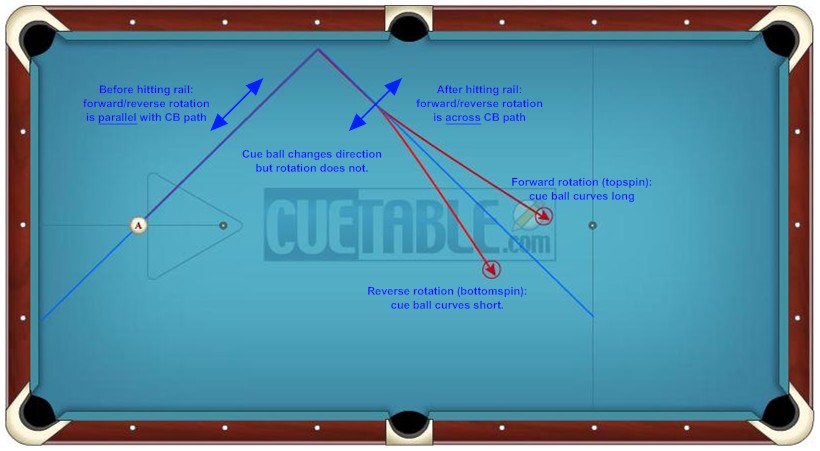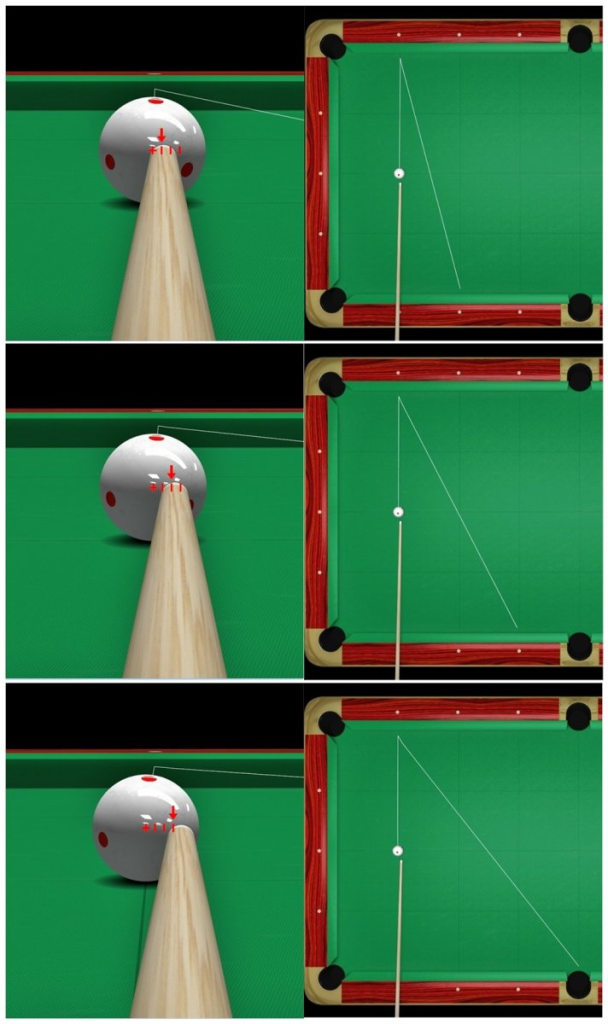What effects does one need to adjust for when aiming bank and kick shots?
Bank and kick shot aiming and diamond systems provide a point of reference only. You will often need to compensate your aim to account for various effects, the most important of which are summarized in the bank speed/cut/spin effects handout, demonstrated in the following videos, and listed below:
Speed:
- In general, more speed shortens the rebound (see NV 6.6), and less speed lengthens the rebound (see NV 6.7); however, see HSV B.41 and NV B.95. One reason faster speed shortens a rolling-CB, angled kick is that the post-rebound curve is delayed by the speed.
- Bank direction consistency is generally better at faster speeds.
Top/Bottom Spin:
- Follow lengthens kick rebound, draw shortens it (e.g., see NV H.2, NV B.29 and NV B.57).
- Less topspin roll (due to faster speed or closeness to rail) means shorter rebound.
- For kick shots with steep approach angles (i.e., almost straight into the rail), topspin roll in results in stun out, and stun in results in roll out (see HSV B.15 – straight-on kick shot rebound losses and spin changes for roll, stun, and draw shots and more info below).
- Banks can be bent short, but only a small amount, and only under certain conditions (see bending a bank shot).
Sidespin:
- Running spin lengthens rebound, and reverse spin shortens the rebound (see NV 6.8). This effect is greatest with the ball heading straight into the rail.
- Running spin results in more CB speed after rebound, and reverse spin results in less CB speed after rebound. The difference is greatest at a moderate approach angle in the rail (i.e., about 20-40° from the rail perpendicular). See also: rail cushion speed changes.
- Sidespin has little effect at shallow angles into the rail (e.g., see HSV A.71). However, the spin will have a large effect off the second rail, where the approach angle will be steep, with the ball heading fairly perpendicular to the rail.
- If the CB has a “natural spin” amount (similar to “gearing spin” for a cut shot), the sidespin won’t change off the cushion. With less sidespin (including “negative” or reverse spin), the cushion will increase the amount of spin, and the angle will shorten (e.g., see HSV 6.5); and for more spin, the amount of spin will decrease off the cushion, and the angle will lengthen (e.g., see HSV A.28).
- At fairly steep angles into a cushion, sidespin direction can reverse (e.g., see twice across and three-times-across bank shots).
Transferred Sidespin:
- An outside cut shortens a bank (see NV 6.12), an inside cut lengthens it (see NV 6.13), unless you use “gearing” outside spin. See also: bank-shot cut-induced-spin effects.
- Spin transfer can significantly affect banks (e.g., left spin on the CB can transfer right spin to the OB which shifts the rebound to the right). For more info, see bank-shot cut-induced-spin effects.
- The cushion imparts spin (and can even reverse the spin direction) on a kicked or banked ball (e.g. see HSV A.31 and two-times and three-times across side bank shots).
- Cut and spin transfer effects are related to throw effects, so a complete understanding of throw helps too.
Equipment Conditions:
- Kicks and banks generally go longer with clean balls on new and clean cloth in a dry environment (see cloth effects and ball condition effects for more info). Although, slick cloth delays the curve forward after rebound, which can make the ball to come up short, especially at faster speed.
- Kicks and banks generally go shorter with rail cushions that are bouncier (i.e., have a higher coefficient of restitution perpendicular to the rail).
Kicking/Banking Systems:
- Standard kicking and banking systems work fairly well on most pool equipment; although, adjustments will be required based on table conditions.
- Diamond brand tables (especially the 7′ tables and the older “Red label” 9′ tables) play much shorter than all other table brands, so significant adjustments will need to be made (by aiming down-table more) when playing on Diamond tables (see Diamond tables banking short).
If one doesn’t understand these effects, or have great intuition built up from years and years of experience (i.e., lots of mistakes and successes), you will not be effective with bank and kick shot mirror and diamond systems over a wide range of shots. Here’s an excerpt from Vol. IV of the Video Encyclopedia of Pool Practice (VEPP) that shows you how to develop a feel for some of the effects during practice:
For more information, see “VEPP – Part XI: Bank Shots” (BD, February, 2013).
Here are some example shots where speed and spin can be used to change the rebound angle and path with kick and bank shots:
For more information, see: “Bending, Twisting, and Stiffening Kicks and Banks” (BD, October, 2016) and the bending a bank resource page.
And one must also be able to adjust to playing conditions and table differences. For more info, see: how to test and check out an unfamiliar table.
For kick shots with steep approach angles (i.e., almost straight into the rail), it sometimes helps to know how topspin and bottom-spin change off the rebound. For more information and examples, see:
- HSV B.15 – straight-on kick shot rebound losses and spin changes for roll, stun, and draw shots
- HSV A.117 – straight-on kick shot at fast speed with follow, stun, and draw
- HSV A.118 – straight-on kick shot at slow speed with follow, stun, and draw
- HSV A.119 – straight-on kick shot of a polished ball at fast speed with follow, stun, and draw
- HSV A.120 – straight-on kick shot of a polished ball at slow speed with follow, stun, and draw
- NV B.18 – Kick shot cue ball hold shot example with Tom Ross
from Patrick Johnson:
For kicks the important thing is what kind of “vertical spin” the CB has on it when it hits the rail:
– CB sliding when it hits the rail will rebound with no curve at the “mirror angle” (minus something for rail friction)
– CB with forward spin (including natural roll) when it hits the rail will curve longer than the mirror angle
– CB with backspin when it hits the rail will curve shorter than the mirror angle
How much longer or shorter the CB rebounds (with forward spin or backspin) depends on how much spin is on the CB* and how much friction there is between the CB and the cloth.
For banks the important thing is how much vertical spin is on the OB when it hits the rail. This can only be controlled by hitting harder or softer (harder = less or no forward spin; softer = more forward spin). This is also why hitting harder shortens bank angles.
*: How much spin is on the CB depends on: – how hard it’s hit – how high it’s hit – how far it is from the rail when it’s hit – how much friction there is between CB/cloth

As this drawing shows, when the CB changes direction off the rail its spin does not change direction. That means that forward or reverse spin which was rotating parallel with the CB’s path before hitting the rail is rotating across the CB’s path after hitting the rail – this across-the-path rotation is what causes the CB to curve after hitting the rail.
Forward rotation (topspin) can be the result of the CB rolling naturally or of hitting high on the CB. Reverse rotation (backspin) can only be the result of hitting low on the CB.
How much does sidespin change the rebound angle?
With typical conditions, as show in the illustration from Patrick Johnson (from AZB post) below, 1/3, 2/3 and 3/3 of maximum spin result in approximately 1, 2 or 3 diamonds of cross-table change with a kick straight into a cushion:

Concerning HSV B.41, why doesn’t speed shorten the rebound angle? Doesn’t the ball compress the cushion sideways more at higher speed, and wouldn’t that create sideways forces that would shorten the rebound angle?
There are many physical effects that control the immediate rebound angle and the amount of massé curving after rebound. I use the phrase “rail throwback” to refer to the effect you are describing. With more speed the cushion deforms more and can generate more sideways force to shorten the angle; however, the rebound angle is also affected by the efficiency (coefficient of restitution = COR) of the cushion, and this can vary with speed and angle also. Based on the results in HSV B.41, these two effects are balancing each other out. The rail throwback effect tries to shorten the rebound angle and the efficiency effect apparently tries to lengthen the rebound (because the cushion is returning less energy, maybe partly because of the ball shift down the rail). This is all conjecture, but it makes sense physically. There are also friction effects between the ball and cushion and ball and table during impact. These might also vary in complicated ways with speed.
Dr. Dave keeps this site commercial free, with no ads. If you appreciate the free resources, please consider making a one-time or monthly donation to show your support:
